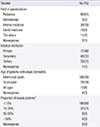Abstract
Purpose
The prevalence of atopic dermatitis (AD) has been increasing in many developed countries including Korea. There has been little information on the status of real clinical practice for atopic dermatitis by physicians in Korea.
Methods
This study investigated the current status of clinical practice on allergy test and treatment of AD in Korea by analyzing a questionnaire survey of 155 physicians who attended the educational program for practical management of AD by the Korean Academy of Asthma, Allergy and Clinical Immunology. The questionnaire was mainly composed of 20 items regarding diagnosis, treatment of AD.
Results
Among the 155 physicians who completed the questionnaire survey, most of subjects (90%) agreed that allergy test was necessary, but only 68% performed allergy test in their practice for AD. The barriers to allergy testing were lack of test personnel or facilities (61%), disbelief on the clinical importance of allergy test in the treatment (41%), and difficulty in explanation about the test results to patients (16%). Problems interfering the active treatment of patients with AD were the difficulty in acquiring a sufficient time for education and explanation about treatment (54%), incomplete clinical efficacy of current medication and concern on the side effects (41%), and the difficulty in establishing a good doctor-patient relationship (40%).
Figures and Tables
Fig. 5
Reasons for not performing active treatment for patients with atopic dermatitis. A, difficulty in acquiring a sufficient time for education and explanation about treatment; B, Incomplete clinical efficacy of current medication and concern on the side effects; C, Difficulty in establishing a good doctor-patient relationship; D, Only current standard drug treatment in not effective enough; E, Despite active therapy, the treatment of income less.

Table 2
The difference between the allergy test necessity recognition and actual test performance in primary medical institution and secondary, tertiary medical institution

References
1. Laughter D, Istvan JA, Tofte SJ, Hanifin JM. The prevalence of atopic dermatitis in Oregon schoolchildren. J Am Acad Dermatol. 2000; 43:649–655.

2. Schultz Larsen F, Hanifin JM. Secular change in the occurrence of atopic dermatitis. Acta Derm Venereol Suppl (Stockh). 1992; 176:7–12.
3. Hong SJ. Korean ISAAC Study Group of Korean Association of Allergy and Respiratory Diseases. Report of Korean ISAAC epidemiologic study for asthma and allergic diseases in children. Pediatr Allergy Respir Dis. 2007; 17:Suppl 1. S55–S66.
4. Williams H, Stewart A, von Mutius E, Cookson W, Anderson HR. International Study of Asthma and Allergies in Childhood (ISAAC) Phase One and Three Study Groups. Is eczema really on the increase worldwide? J Allergy Clin Immunol. 2008; 121:947–954.e15.

5. Leung DY, Boguniewicz M, Howell MD, Nomura I, Hamid QA. New insights into atopic dermatitis. J Clin Invest. 2004; 113:651–657.

6. National Health Insurance Corporation [Internet]. Seoul: National Health Insurance Corporation;c2000. cited 2012 Sep 24. Available from: http://www.nhic.or.kr./cms/board/board/Board.jsp?act=VIEW&communityKey=B0039&boardId=22557.
7. Oh JW. Recent situation of the management of atopic dermatitis. Korean J Asthma Allergy Clin Immunol. 2012; 32:14–15.
8. Lee JB, Rha YH, Choi SH. A questionnaire survey of care-givers' understanding of atopic dermatitis. Korean J Asthma Allergy Clin Immunol. 2009; 29:179–185.
9. Kim HB, Cho YJ, Yoo KH, Kim DY, Kim J, Kim H, et al. Survey on the management of atopic dermatitis. Korean J Asthma Allergy Clin Immunol. 2012; 32:16–20.
10. Kim JK, Kim JH, Lim DH, Son BK. Qualitative assessment of atopic dermatitis-related websites. Pediatr Allergy Respir Dis. 2007; 17:282–288.
11. Lee HJ, Lee JH, Lee YW, Kim CW, Dhong HJ, Park HS, et al. Multicenter analysis of the current status of unproved complementary/alternative medicine other than herbal medication in allergy patients. Korean J Med. 2011; 80:68–77.
12. Park JS, Kim BJ, Park Y, Lee SY, Kim WK, Kim JE, et al. KAAACI Work Group Report on the Treatment of Severe/Recalcitrant Atopic Dermatitis. Korean J Asthma Allergy Clin Immunol. 2010; 30:255–270.
13. Rhim JW, Moon KS, Kong DY, Pyun BY. An Investigation into the actual condition of outbreak and treatment in atopic dermatitis. Pediatr Allergy Respir Dis. 2005; 15:44–52.
14. Hanifin JM, Cooper KD, Ho VC, Kang S, Krafchik BR, Margolis DJ, et al. Guidelines of care for atopic dermatitis, developed in accordance with the American Academy of Dermatology (AAD)/American Academy of Dermatology Association"Administrative Regulations for Evidence-Based Clinical Practice Guidelines". J Am Acad Dermatol. 2004; 50:391–404.
15. BuBmann C, Bieber T, Novak N. Systemic therapeutic options for severe atopic dermatitis. J Dtsch Dermatol Ges. 2009; 7:205–219.

16. Kim DH, Kang KH, Kim KW, Yoo IY. Management of children with atopic dermatitis. Pediatr Allergy Respir Dis. 2008; 18:148–157.




 PDF
PDF ePub
ePub Citation
Citation Print
Print









 XML Download
XML Download